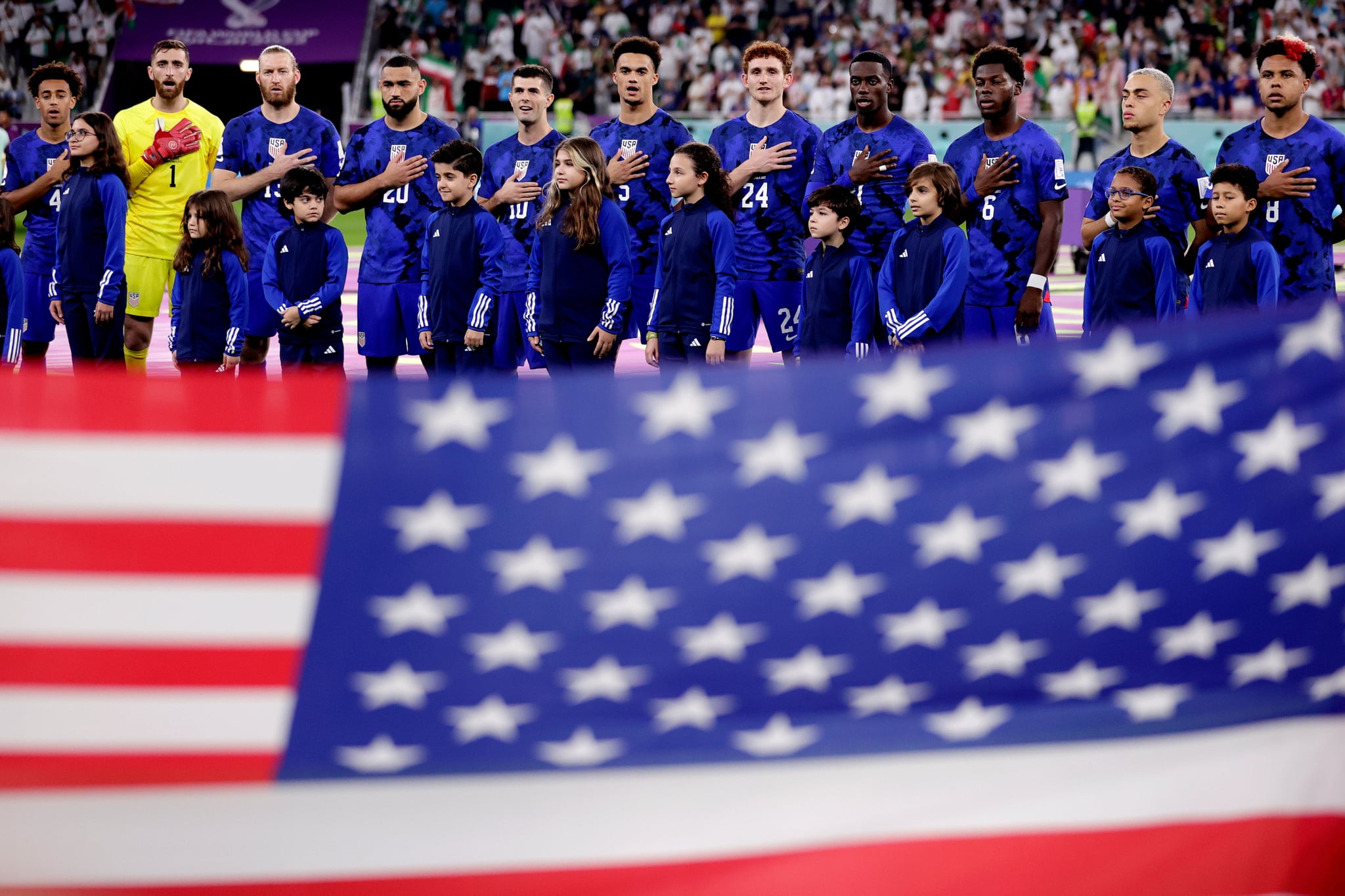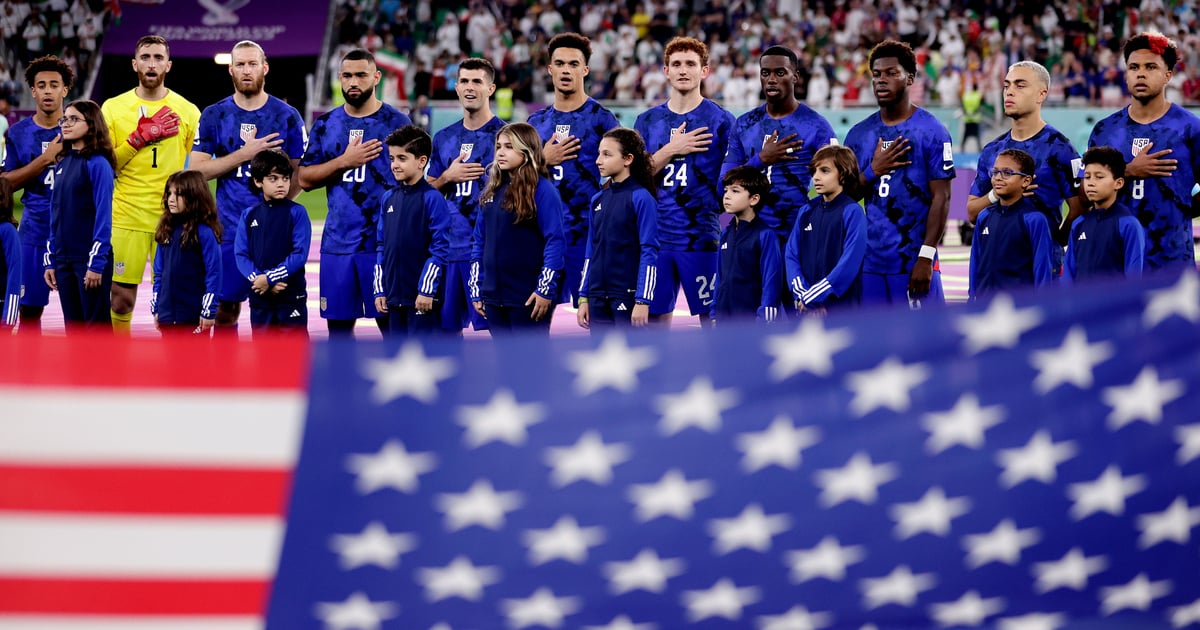
The US Men’s National Team (USMNT) advanced to the Round of 16 in the men’s World Cup with a win over Iran yesterday, and the players on the field aren’t the only ones reaping the benefits. Thanks to the new collective bargaining agreement between the USMNT and the US women’s national team (USWNT), the men’s and women’s teams will split the prize money that the men win in this World Cup, including the $13 million they get for qualifying for the next rounds — a first in international soccer.
That means that the women could already be taking home around $6 million, just from the men moving on to the next stage. Incredibly, that amounts to more prize money than the USWNT took home from winning the past two women’s World Cups, combined.
According to Power Plays, the USWNT won $2 million for winning the 2015 women’s World Cup and $4 million for their 2019 win. To compare, following their victory over Iran, the men’s team will now receive at least $13 million — even if they lose their next game. Should they win and advance to the next round, the prize money ratchets up to $17 million. It increases every round thereafter, with the men’s World Cup winners receiving $42 million.
The pay disparity between the men’s and women’s World Cups is shameful in its own right, and we’ll dig into that in a minute. But first, let’s get back to that collective bargaining agreement. In May, the USWNT’s years-long fight for equal pay culminated in a new CBA, signed by US Soccer and the men’s and women’s players’ associations. The agreement stipulated, among other things, that 90 percent of World Cup-related prize money won by either team will be “pooled and shared equally” between the men’s and women’s teams, with US Soccer taking a 10 percent cut.
According to US Soccer, the federation is the first in the world to equalize World Cup prize money across men’s and women’s teams. “The agreements will ensure that U.S. Soccer’s Senior National Team players remain among the highest paid in the world,” US Soccer said at the time.
Per that agreement, the $13 million already won by the USMNT will be split between the men’s and women’s teams, minus the 10 percent that goes to US Soccer. That amounts to about $5.85 million going to each team.
If you spend any time at all on the sports side of the internet, it won’t shock you to hear that some people are mad about this, apparently on behalf of the men’s team (who, again, voluntarily agreed to this CBA). Goals, a women’s sports consulting agency, rounded up a few of the more cringeworthy takes in an Instagram post for those of us who didn’t wade through the toxic comment sections ourselves. “Getting paid for not doing anything. That’s pretty embarrassing,” said one person, because apparently winning four World Cups qualifies as “not doing anything.”
“It’s basically 2 completely different sports,” said someone else. “One has a lot of revenue, the other very little. How they earn anything close to equal baffles me.” And my personal, tired favorite: “There’s a reason why the two achievements are incomparable . . . The ability, quality and skill of the women’s game is far inferior.”
Alex Morgan would probably nutmeg all of these tough-guy commenters in 0.1 seconds, but that’s not the real issue here. As ever, the majority of internet trolls remain unaware of just how popular women’s sports are and how quickly they’re growing. Women’s soccer alone has demonstrated sustained growth in interest and viewership for years. The 2019 women’s World Cup drew a record 1.12 billion total viewers on television, according to FIFA, with 14.3 million US viewers tuning in for the final between the USWNT and the Netherlands. Since we’re doing comparisons, that’s 22 percent more than the 2018 men’s World Cup final (11.4 million US viewers), according to Fox Sports via CNBC. That 2019 women’s World Cup final was also the most-watched soccer match on English-language television — men’s or women’s! — in the US since (oh, look at that) the 2015 women’s World Cup final (25.4 million viewers).
And that’s just in the US. Globally, the patterns are similar. The women’s Euro 2022 tournament set a record of 365 million global cumulative live viewers, more than double 2017’s number of 178 million viewers, according to UEFA. The Guinness world record for largest attendance at a women’s soccer match (a record held set by the USWNT during the 1999 World Cup and held for 23 years) was broken twice this year and is now held by FC Barcelona Femení and VfL Wolfsburg, who drew 91,648 to a game in Barcelona on April 22.
While we’re at it: the National Women’s Soccer League (NWSL) in the US also broke regular season and playoff attendance records this year. Alexis Ohanian (cofounder of Reddit, lead investor of the NWSL’s Angel City club, husband of Serena Williams, father of Olympia, etc.) told SportsCenter in September that investing in women’s soccer was “the most obvious, best sports investment I could make . . . it was so obviously undervalued.” When we think of American soccer excellence, he elaborated, “we think of the women . . . when we think of soccer, the most popular sport in the world, it’s the women who have carried the crown for us.”
To quote one of our commenters above, the “ability, quality and skill” of women’s soccer players is enough to attract fans in droves. If the revenue isn’t there, it’s not because the sport isn’t popular — it’s because women’s soccer, and women’s sports in general, continue to be heavily undervalued by media and by the very organizations the teams operate under. The NCAA’s absurd evaluation of the women’s March Madness tournament is one example: according to a third-party review published last year, the NCAA had been valuing the women’s tournament at about $6 million a year. The actual value? Upwards of $80 million, potentially.
In soccer, FIFA itself (hardly a bastion of equality) recently criticized TV deal offers for the 2023 women’s World Cup, with FIFA president Gianni Infantino saying that some offers were “100 times less, even more than 100 times in some occasions” than the value of the men’s World Cup rights deal, according to the Associated Press. “We are not going to accept this,” Infantino said, “because we know that the viewing figures for these broadcasters in some big footballing countries for the men’s World Cup or for the Women’s World Cup are actually very similar . . . meaning their commercial income is very similar for men and for women.”
The USWNT deserve much more than they’ve received from their World Cup success.
Women’s soccer players and fans are both contributing to the growth of the sport, but at a certain point, it falls on organizations (FIFA, US Soccer) to force broadcasters and sponsors to give the players what they’re due. And that means those organizations themselves need to recognize the monetary value in the women’s teams — the value of women athletes, who have so often been denigrated or simply overlooked despite their success and popularity.
That brings us back to the US national teams’s joint CBA, which was a clear step in the right direction and which, by all accounts, both teams were proud to sign on to. “They said equal pay for men and women was not possible, but that did not stop us and we went ahead and achieved it,” said USMNT defender Walker Zimmerman, according to an article published by US Soccer. Zimmerman was among the leaders on the men’s team who took part in negotiations. “We hope this will awaken others to the need for this type of change,” he continued, “and will inspire FIFA and others around the world to move in the same direction.”
Because that’s the real issue. Internet trolls can justify lower pay to women’s players with “inferior quality” and lower revenue all they want. Maybe they think they’re standing up for the men’s team, but those players all signed on to that CBA. They’ve known since March that any prize money they make in this World Cup will be split with the women’s team, just as the women’s prize money will be split next year; it’s a deal they appear to take pride in. “This is a great deal for both teams,” Zimmerman emphasized in a June interview on the Football Americana podcast. “What an amazing opportunity to do something historic and step up to the plate and be the first federation, [the] first men’s and women’s side to agree to exactly equal pay.”
No, the men’s team seems fine with this. In this case, the organization the trolls are ultimately defending is FIFA, which may offer $60 million in total prize money at the next women’s World Cup, according to Power Play, compared to $440 million at the men’s World Cup. And yes, Infantino can point to unfair media rights deals — and broadcasting corporations have a lot to answer for as well — but this is an organization expected to rake in $7 billion by the end of this four-year World Cup cycle, according to AP. It’s hard to imagine FIFA truly can’t afford to pay the women’s teams an equal amount, or at least appreciably more than what they get now in prize money, which in 2023, may be more than seven times less than the men.
Based on their performance and popularity, the USWNT deserve much more than they’ve received from their World Cup success, but they can’t control what FIFA gives them. That’s why US Soccer and the men’s and women’s teams took this step themselves, through a CBA that guarantees equal pay, in the hopes that it not only makes the playing field more even but also serves as an example to other national federations and, ultimately, FIFA itself.
